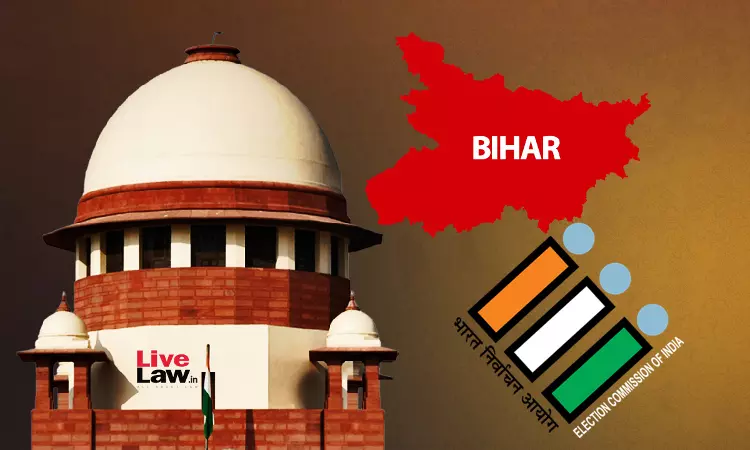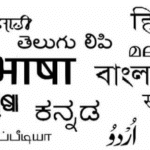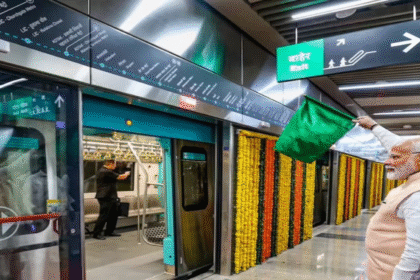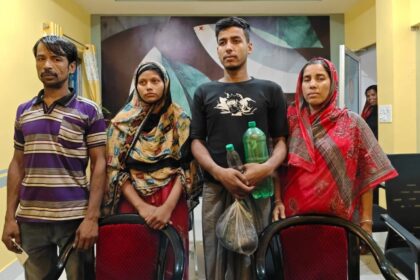Bihar BLOs Uploaded Voter Enumeration Forms Without Consent, ADR Tells Supreme Court
In a startling development that could shake the foundational trust in India’s electoral process, the Association for Democratic Reforms (ADR) has filed a petition before the Supreme Court, alleging that Booth Level Officers (BLOs) in Bihar uploaded voter enumeration forms en masse without the knowledge or consent of citizens. The issue, while initially appearing administrative, carries grave implications for data protection, individual consent, and democratic integrity.
According to the ADR, which has long been an advocate for transparency and accountability in India’s democratic institutions, this mass uploading involved sensitive and personally identifiable voter information. These entries, made without verification or consent, were allegedly done in a hasty or potentially politically motivated manner. The implications of such actions span beyond simple data breaches; they touch upon constitutional rights such as the Right to Privacy under Article 21.
The ADR’s legal submission details how voters, particularly in rural and semi-urban areas, were unaware that their personal information was being uploaded and potentially shared or accessed by third parties. The voter enumeration process typically requires physical verification, personal outreach, and signed consent forms. However, the current allegation points toward a systemic circumvention of these standard procedures.
Initial reports and citizen complaints collected by ADR reveal that enumeration forms—meant to be voluntarily filled out by the electorate—were being pre-filled or manipulated by local officials under the guise of streamlining electoral rolls. In a country where voting rights are constitutionally protected and treated with solemnity, the idea that these forms were uploaded without engagement or permission is deeply disturbing.
The case has already begun to attract wider national attention. Electoral reform experts, civil society advocates, and data privacy professionals have weighed in, urging the Election Commission of India (ECI) to launch a parallel investigation while the Supreme Court deliberates on the legal and constitutional dimensions.
As the court prepares to examine the evidence and hear arguments, the focus shifts not only to electoral officials in Bihar but also to larger questions about oversight, consent, and digital governance in India. In this unfolding story, the right to vote is at the center—but so too is the citizen’s right to control their personal data.
Legal Ramifications and Democratic Accountability
The ADR’s petition before the Supreme Court is more than just a call for remedial action—it is a landmark moment in the ongoing dialogue about data rights and electoral reform in India. By invoking the Right to Privacy, as articulated in the 2017 Puttaswamy judgment, the ADR draws attention to the constitutional violations embedded in unauthorized data collection.
The legal battle unfolding in the Supreme Court could set a precedent for how electoral authorities manage sensitive voter information in a digital era. At the core of the case lies a critical question: Can the state, under the pretext of efficiency or administrative convenience, override individual consent and autonomy?
Senior advocates representing ADR have reportedly submitted detailed affidavits that document how the mass-uploading practice bypassed legal safeguards. These include the Representation of the People Act, 1950, which outlines the procedures for preparing and revising electoral rolls, and guidelines issued by the Election Commission of India (ECI) that stress due diligence and citizen participation.
Legal scholars observing the case note that a favorable ruling for ADR could lead to tighter statutory frameworks for electoral data management, including mandatory digital audits, consent mechanisms, and penalties for violations. It might also strengthen the framework around the role and accountability of BLOs, who are often seen as the face of the electoral system in grassroots India.
What’s at stake is not merely the accuracy of Bihar’s voter rolls, but the sanctity of democratic participation. If individuals are unaware or unable to control how their personal information is being recorded or manipulated, it undermines the very foundation of free and fair elections.
As the case proceeds, it is expected that the Supreme Court will also seek responses from the ECI and the state government of Bihar. Their defense—or lack thereof—will further illuminate the procedural lapses and systemic weaknesses that allowed such unauthorized data entry to occur.
Public discourse is intensifying. Social media platforms, academic circles, and political commentators are amplifying the issue, calling for a comprehensive overhaul of how voter data is managed in the world’s largest democracy. The ADR’s move, while legal in nature, is igniting a broader civic consciousness around digital rights, surveillance, and the limits of state power.
As the legal debate plays out in the hallowed halls of the Supreme Court, an equally important narrative is emerging from the ground: the voice of the ordinary voter. From the dusty lanes of Darbhanga to the suburban neighborhoods of Patna, confusion and concern ripple through local communities as more citizens come to realize that their personal details may have been accessed, stored, or uploaded without their permission.
In interviews conducted by civil society volunteers and regional media outlets, many citizens expressed bewilderment. Some were unaware that a voter enumeration process had even occurred in their areas. Others recounted being asked to sign blank forms by local BLOs without understanding their purpose, while a few, more alarmingly, insisted they had not interacted with any electoral officer at all in recent months—yet their records show updated information.
This disconnect points to a dangerous erosion of trust. For millions of Indians, especially those in marginalized or semi-literate populations, the relationship with electoral institutions is already fraught with ambiguity and skepticism. The very officials meant to safeguard democratic rights appear, in these instances, to have acted without transparency or accountability.
One resident from Muzaffarpur, a retired schoolteacher named Ram Charitra Yadav, stated, “For years, we have respected the BLOs because they were seen as the bridge between us and the system. If they act without our knowledge, how can we believe the system still protects us?”
The ADR’s petition has sparked a wave of grassroots discussions across Bihar. Non-profits have begun holding awareness sessions to educate voters about their rights regarding electoral data and consent. The local press, too, has amplified voices from affected communities, some of whom are now demanding state-level inquiries into the conduct of BLOs.
In the digital age, the consequences of unauthorized data sharing are not confined to the misuse of electoral rolls. Personal information—names, addresses, ages, family members, and more—can be weaponized, whether for targeted political campaigning, financial fraud, or identity manipulation.
This fear was echoed by a young voter in Gaya, who remarked, “Today they upload my form without asking. Tomorrow will someone use my details to cast a vote on my behalf?”
Beyond the psychological toll, the tangible impacts are beginning to surface. Several citizens reported discrepancies in their voter ID details or sudden deletions and relocations in constituency records. These instances highlight how manipulation—or mismanagement—at the data collection stage can cascade into electoral injustice at the ballot box.
While the Supreme Court deliberates the legal contours of the case, it is this breach of public trust that remains the most urgent and human dimension of the controversy. In a democracy, participation begins with inclusion and respect. When that foundation is shaken, the entire edifice of electoral legitimacy stands threatened.
To understand the magnitude of the allegations and their implications for India’s democratic machinery, it is essential to examine the institutional role and responsibilities of the Booth Level Officer (BLO). Often referred to as the “face” of the Election Commission at the grassroots level, the BLO plays a pivotal role in maintaining the sanctity of the electoral rolls.
The Intended Function of BLOs
Appointed under the guidelines of the Election Commission of India (ECI), BLOs are typically schoolteachers, government employees, or other local officials tasked with duties such as:
- Verifying voter identity and residence details
- Distributing and collecting Form 6 (new voter registration), Form 7 (deletion), Form 8 (modification), and Form 6A (overseas voter registration)
- Assisting voters in filling these forms accurately
- Submitting verified data back to the Electoral Registration Officer (ERO)
Crucially, the process requires in-person interaction, authentication of supporting documents, and signature or thumb impression of the voter to establish both legitimacy and consent.
The Alleged Breakdown
According to the ADR’s petition and multiple independent accounts, this legally mandated process was bypassed on a mass scale. BLOs in several districts allegedly uploaded enumeration forms using preexisting information from older rolls or through unofficial means, without verifying details in person or obtaining voter consent.
Instead of physical visits or personal interviews, entries were reportedly done in bulk from administrative offices or using external agents. This systemic short-circuiting led to forms being submitted with errors, without citizen awareness, and without adherence to due process.
The fallout of such malpractice is twofold:
- Administrative Breakdown: It compromises the integrity of electoral rolls, potentially leading to duplication, deletion, or misplacement of voter entries. For example, names could appear in multiple constituencies, dead voters might remain active, or legitimate voters may be excluded.
- Democratic Erosion: If BLOs—who serve as the public’s only link to the electoral machinery—violate protocols, the public’s trust in the voting system erodes. Especially in Bihar, where the political climate is often fraught with tensions and high-stakes contests, the reliability of voter data is crucial to ensuring peace and fairness.
Institutional Accountability and Oversight
The Election Commission’s guidelines require District Election Officers (DEOs) and Electoral Registration Officers (EROs) to periodically audit BLO activity. However, the ADR’s findings suggest that oversight mechanisms either failed or were willfully ignored.
This raises important questions:
- Were DEOs complicit or unaware of the violations?
- Did political pressure influence BLO conduct?
- Were BLOs given quotas or informal targets that encouraged shortcuts?
The absence of clear answers points to systemic vulnerabilities. If BLOs can manipulate or fabricate voter data without consequence, the door opens to large-scale electoral fraud.
The Human Cost
Behind this institutional crisis lies a very human impact. Citizens like Shabnam Khatoon from Samastipur, whose name was removed from the electoral roll despite voting in the previous election, now face bureaucratic hurdles to re-register. Many complain of being redirected from one office to another, forced to resubmit documents, or unsure whether they will be able to vote in upcoming elections.
Civil liberties groups have begun to argue that BLOs, while essential to the electoral process, must be more stringently vetted, trained, and monitored. Some have even suggested the need for independent observers during the voter enumeration process, particularly in politically sensitive regions.
Toward Reform
The Supreme Court case provides a rare opportunity to reform this crucial cog in India’s electoral engine. If it results in legally binding orders around BLO conduct, consent mechanisms, and digital audit trails, it could set a national benchmark.
But for that to happen, the judiciary must recognize the gravity of the breach—not just in terms of rules violated, but in terms of trust broken.
The Digital Infrastructure Dilemma — Technology Without Safeguards
While much of the public discourse around the Booth Level Officer (BLO) misconduct in Bihar focuses on human error or political malpractice, a deeper issue underlies the controversy: India’s vulnerable digital infrastructure for electoral data management. The alleged mass-uploading of voter forms without verification or consent reveals a critical technological blind spot—the absence of robust checks, balances, and consent-based architecture within India’s electoral IT systems.
The Digital Leap — Without a Safety Net
Over the last decade, the Election Commission of India (ECI) has made significant strides in digitizing electoral processes. Online voter registration, digital voter lists, electronic submission of forms, and integrated databases have streamlined administration and reduced manual dependency. However, digitization without transparency and traceability can just as easily become a liability.
In Bihar, ADR’s petition highlights that the centralized online system used by BLOs allowed them to upload voter forms using their credentials without proper verification layers. There were no biometric checks, no digital signature requirements, and no second-tier approvals—allowing BLOs, once logged in, to operate unchecked.
This creates a dangerous paradox: the same digital tools designed to enhance transparency have enabled silent manipulation at scale.
Consent in a Click: A Flawed Model
In most digital governance frameworks, user consent is not just a moral imperative but a legal one. Whether under India’s Data Protection Bill (now law as of 2023) or international standards like the GDPR, collecting personal data—such as name, address, age, or ID proof—requires clear, informed, and explicit user consent.
The BLO case subverts this principle entirely. Reports suggest that forms were pre-filled based on previous data or assumptions, and then uploaded as “voluntarily submitted” by the voters. In some cases, citizens only discovered they had been enrolled—or had their details changed—when they checked the electoral rolls online or were denied voting access.
The lack of digital safeguards means there was no record of who consented, no logs of confirmation, and no digital paper trail to validate the process. This absence of traceability undermines both administrative accountability and judicial remedy.
The Limits of Automation Without Authentication
In 2020, the ECI had announced ambitious plans to link voter IDs with Aadhaar in an effort to eliminate duplication and fraud. While the move promised to clean up the electoral rolls, it also raised alarms among privacy advocates who warned against centralized profiling and unauthorized data sharing.
The Bihar case adds weight to those concerns. If unauthorized uploads can occur on this scale, linking Aadhaar—which contains biometric and demographic data—to an already vulnerable system only increases the risk of mass surveillance, identity theft, and state overreach.
Experts warn that the lack of end-to-end encryption, two-factor authentication, and role-based access controls within the electoral IT ecosystem is a ticking time bomb. A malicious actor or compromised BLO login could potentially alter the fate of an entire constituency’s voter data—without detection.
Lessons From Abroad
Globally, electoral commissions in countries like Estonia, Canada, and Germany have implemented rigorous digital voting safeguards:
- Multi-factor identity verification
- Digital consent capture with timestamped records
- Independent IT audits and open-source code reviews
- Blockchain-based voter roll logs for traceability
India’s scale may be unmatched, but so are its stakes. The digital backbone of its democracy must reflect not just technological ambition but democratic responsibility.
A Call for Legislative and Technological Reform
The ADR’s Supreme Court petition, while rooted in electoral rights, may inadvertently trigger a larger legislative reckoning: the need to overhaul India’s digital governance architecture with citizen-first principles. Key recommendations already surfacing include:
- Mandatory consent fields and voter OTP verification before any form upload
- Automated red-flag systems to detect mass uploads from a single BLO login
- Decentralized verification checkpoints involving both BLOs and EROs
- Third-party tech audits of state-level electoral data systems
Without these reforms, India risks allowing convenience to override constitutional safeguards.
A Democracy at a Digital Crossroads
The Bihar BLO form upload scandal is not just about misconduct; it is a symptom of a broader malaise—a democratic system trying to run on digital rails without having laid the foundation of ethics, consent, and citizen control. The Supreme Court’s judgment will not only determine liability but could also shape the future blueprint of digital voting infrastructure in India.
Whether India’s electoral system emerges more secure, transparent, and citizen-centric—or remains vulnerable to quiet manipulation—will depend on the institutional courage to act now.
Also Read : India BJP English Language Policy Sparks Cultural Tensions and National Debate








